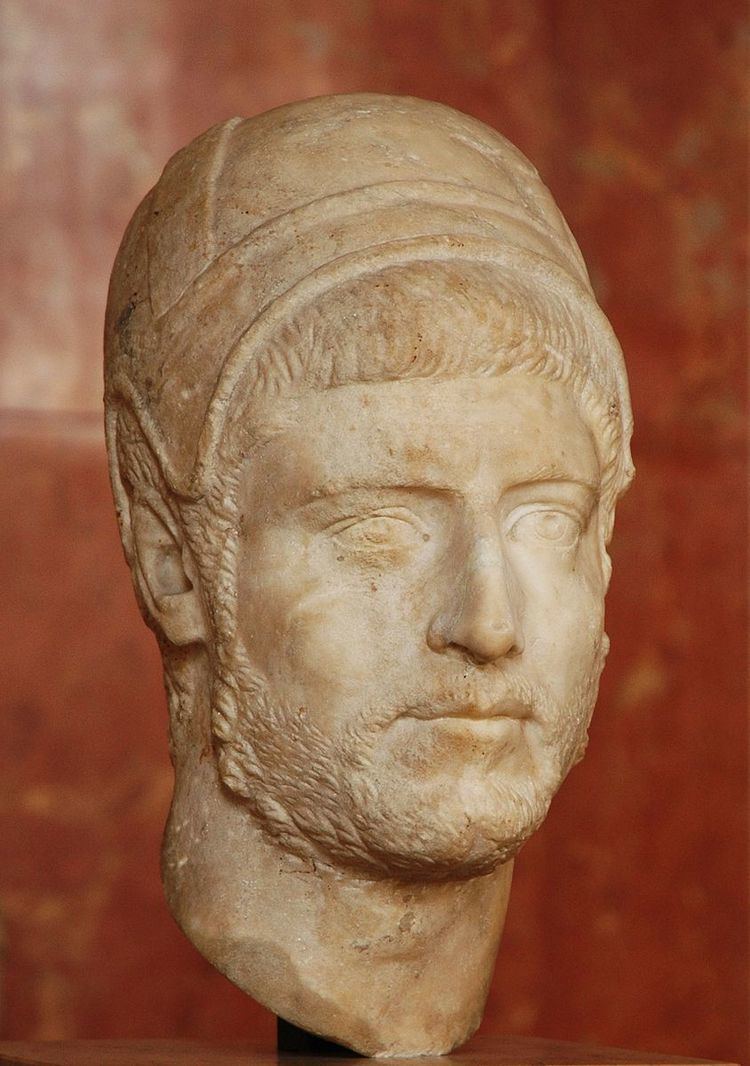 | ||
In ancient Roman religion, the Saliī (/ˈsæliˌaɪ/, ['sʌlɪiː]) were the "leaping priests" (from the verb saliō "leap, jump") of Mars supposed to have been introduced by King Numa Pompilius. They were twelve patrician youths, dressed as archaic warriors: an embroidered tunic, a breastplate, a short red cloak (paludamentum), a sword, and a spiked headdress called an apex. They were charged with the twelve bronze shields called ancīlia, which, like the Mycenaean shield, resembled a figure eight. One of the shields was said to have fallen from heaven in the reign of King Numa and eleven copies were made to protect the identity of the sacred shield on the advice of the nymph Egeria, consort of Numa, who prophesied that wherever that shield was preserved, the people would be the dominant people of the earth.
Contents
Each year in March the Salii made a procession round the city, dancing and singing the Carmen Saliare. Ovid, who relates the story of Numa and the heavenly ancīle in his Fasti (3.259–392), found the hymn and the Salian rituals outdated and hard to understand. During the Principate, by decree of the Senate, Augustus' name was inserted into the song (Res Gestae 10). They ended the day by banqueting. Saliaris cena became proverbial for a sumptuous feast.
King Tullus Hostilius is said to have established another collegium of Salii in fulfilment of a vow which he made in the second war with Fidenae and Veii. These Salii were also twelve in number, chosen from the patricians, and appeared to have been dedicated to the service of Quirinus. They were called the Saliī collīnī, Agonales, or Agonenses.
It is unclear whether the primary aim of the ritual was to protect Rome's army, although this is the traditional view.
Founder
In addition to the myth of the ancile, several other explanations are offered in Greek and Latin sources for the founding of the priesthood. An origin among the Etruscans is attributed to a founding by Morrius, king of Veii. The Salii are also given an origin in connection with Dardanus and the Samothracian Di Penates, or the Salius who came to Italy with Evander and in the Aeneid competed in the funeral games of Anchises.
Interpretations of the rituals
Georges Dumézil interpreted the rituals of the Salii as marking the opening and the closing of the yearly war season. The opening would coincide with the day of the Agonium Martiale on March 19, and the closing with the day of the Armilustrium on October 19. The first date was also referred to as ancilia movere, "to move the ancilia," and the second as ancilia condere, "to store (or hide) the ancilia." Dumezil views the two groups of Salii — one representing Mars and the other Quirinus — as a dialectic relationship showing the interdependency of the military and economic functions in Roman society.
Classical philologist Georg Wissowa maintained that the ritual of the Salii is a war dance or a sword dance, with their costumes clearly indicating their military origin.
Because the earliest Roman calendar had begun with the month of March, Hermann Usener thought the ceremonies of the ancilia movere were a ritual expulsion of the old year, represented by the mysterious figure of Mamurius Veturius, to make way for the new god Mars born on March 1. On the Ides of March, a man ritually named as Mamurius Veturius was beaten with long white sticks in the sacrum Mamurii, in Usener's view as a form of scapegoating. Mamurius was the mythic blacksmith who forged eleven replicas of the original divine shield that had dropped from the sky.
According to Usener and Ludwig Preller Mars would be a god of war and fertility while Mamurius Veturius would mean "Old Mars". Mars is himself a dancer, and the head of the Salian dancers, patrician young men whose parents were both living (patrimi and matrimi). Wissowa compares the Salii with the noble youth who dance the Lusus Troiae. The ritual dance of the Salii would thus be a coalescence of a initiation into adulthood and war with a scapegoat ritual (see also pharmakos).
Other 19th-century scholars have compared the rituals of the Salii with the Vedic myths of Indra and the Maruts.
Ancient authors quoted by Maurus Servius Honoratus and Macrobius recorded that Salii had existed at Tibur, Tusculum and Veii even before their creation in Rome.
Nomenclature
Salian virgins
Sextus Pompeius Festus makes a perplexing reference to "Salian virgins" (saliae virgines). Wearing the paludamentum and pointed apex of the Salii, these maidens were employed to assist the College of Pontiffs in carrying out sacrifices in the Regia. It has been suggested that the passage in Festus describes a transvestite initiation. An earlier explanation held that the maidens played the role of absent warriors in some form of propitiation. The meaning of their being "hired" is unclear.
